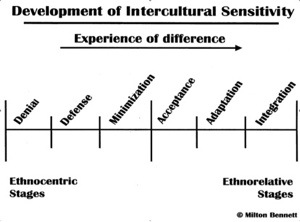Today I would like to take some time to talk about the so-called “Bennett scale” also
known as the DMIS, the “Developmental Model of Intercultural Sensitivity“. This model, developed by Dr. Milton Bennett in the late 80s, serves as a framework to explain the reactions of people to cultural
difference.

As shown above, the experience of difference as a function of your own perception moves through different stages, from “ethnocentrism” to “ethnorelativism“. The first term simply means that you experience your own culture as central and the second that you actually experience your culture in the context of other cultures. The more interculturally competent you are, the more you would find yourself on the right side of the diagram.
The six distinct kinds of experiences on the continuum of development are called (following Dr. Bennett’s explanations which can be found here):
After reading this you might want to challenge yourself and find out where you would be in this model. Which perception of yourself and others around you do you have and how competent do you deal with cultural difference?
When I was in Milano with Dr. Bennett a couple of weeks ago, it struck me that this model allowed me to finally understand what I had experienced during the course of my life and why I had felt the way I did. I actually went through all of the different perspectives myself, learning and changing views, to finally aquire competence and by that a kind of “peace” and acceptance within myself.
If you are reading my blog since a while you might know that I grew up in Belgium with German parents and wthin a completely European and multilingal environment as I went to the European School. Subsequently I then chose a European study path and an international career which now make me to a sellf-declared “chameleon“.
As it did for me, maybe this model can help you too, on your path to understanding who you are and where you want to be! The good news is that intercultural competence can be learned. As an intercultural coach and a mindful leader I can accompany you on that path if you want to….
Looking forward to reading your comments and/or to hearing from you! Jenny


Pingback: Walking towards intercultural competence | Mind...
Thank you so much Jenny for introducing (to me) this model! I’m writing an article about ex-European school students and was looking for something like this! From chameleon to chameleon 😉 : Thanks a lot!
LOL well, this model really helped me a lot!! Dr. Bennett is excellent and published many things. I am already looking forward to my next course with him. We definitely need to meet soon…what about a skype chat to start with?! Ciao, ciao, Jenny
That would be a good idea. I haven’t started yet with studying because I really need to find out where and when (and what exactly), but maybe you can give me a hint then 😉 Ciao ciao e a presto, Ute
Pingback: Walking towards intercultural competence | Appl...
I have used this model often but I find that those who have little or no intercultural experience find it hard to understand the stages, like you say it is when you have been through them that you can reflect better. People at the Denial stage tend to get defensive but the model helps lead discussion in a group so they realise that others are at different stages and so they have to rethink their position!
Very true indeed! I would recommend using it for coaching/training purposes or in leadership situations to become more effective with multicultural teams. Thanks for stopping by! Jenny
Pingback: Walking towards intercultural competence | Inte...
Pingback: Walking towards intercultural competence | Europe Direct NI
Very interesting! It would be interesting as well to analyse this within the EU (among members) and how this diagram could be applied in correspondence with another concept- “glocalization”. Just a thought…
Hi Gabi, how would you describe your ‘glocalization’ concept?
This model is new to me but, even on brief reflection, so very relevant. In my little province, NL, Canada, I fear we are generally too far on the ‘wrong’ side of the scale and with much work ahead.
Hi there, Dr. Bennett’s model is very relevant indeed, especially,when coaching/training in the context of intercultural communications. Intercultural competence can be learned but of course people need to be open enough to understand its value. Thanks for your comment! Jenny
Pingback: Intercultural Development Research Institute – Blog | Mindful Leadership & Intercultural Communication
Pingback: Research Paper: The roles of coaching in experiential intercultural … | Mindful Leadership & Intercultural Communication
Pingback: Foreign assigments and what it could feel like – a real life example | Mindful Leadership & Intercultural Communication
Pingback: Colours and Cultural Differences | Mindful Leadership & Intercultural Communication
Pingback: Intercultural competence begins with self-awareness | Jenny Ebermann
Pingback: Walking towards intercultural competence | find...
Pingback: Walking towards intercultural competence | Inte...